Fantastic recipe! First time using Philadelphia cream cheese in pasta and the family loved it. They asked me to make it again for our next gathering.
Get ready, pasta lovers, because we're about to make your taste buds dance with a recipe that's as comforting as it is flavorful! Today, we're whipping up a sumptuously creamy Pasta with Philadelphia Cream Cheese that's going to change the way you think about weeknight dinners forever.
We're taking two universal comfort food favorites - pasta and cream cheese - and marrying them in a beautifully simple yet utterly irresistible way. And while you might usually associate Philadelphia Cream Cheese with bagels and cheesecakes, we're about to show you its savoury side.
This recipe features the magic that happens when you melt butter, blend in the soft Philadelphia Cream Cheese, and marry it with pasta boiling water. The result is a creamy, dreamy sauce that perfectly coats every strand of pasta, giving it a velvety richness that's hard to resist. And, of course, we'll add a sprinkle of black pepper to bring a touch of warmth and elevate the dish with its depth of flavor.
And the best part? You'll be enjoying your mouthwatering pasta dish in no time at all! This is one of those quick, easy meals that feels fancy but is really simple to put together. Even on your busiest days, you can turn to this recipe for a guaranteed satisfying and delicious dinner.
JUMP TO:
INGREDIENTS:
Penne Pasta: When choosing penne pasta, opt for high-quality pasta that is either imported from Italy or made with durum wheat semolina, as they tend to have a better texture and flavor. The ridges and hollow center of penne are perfect for capturing and holding onto the creamy Philadelphia sauce. If you're looking for healthier alternatives, consider whole grain or gluten-free options. Remember, the type of pasta could influence the cooking time, so always refer to the package instructions.
Philadelphia Cream Cheese: This ingredient provides the rich, creamy texture and slightly tangy flavor that makes this dish stand out. Philadelphia is a well-known brand, but you can use any cream cheese of high quality. When buying cream cheese, check the best-by date to ensure freshness. If you want a lighter version, you could opt for reduced-fat or Neufchâtel cheese. For a dairy-free version, there are several plant-based alternatives available, but remember, they might alter the final taste of the dish.
Pasta Boiling Water: Using pasta boiling water is not just about resourcefulness, but it's a secret weapon to make the sauce more flavorful. This water is starchy and salty, which helps in binding the sauce together and also enhances the overall flavor. The key is to adequately salt your pasta water (it should taste like the sea).
MAIN STEPS:
Cooking the Pasta: The first step may seem simple, but there's a lot more to it than meets the eye. Over or under-cooked pasta can make or break this dish. Always follow the packet instructions for the exact cooking time to achieve 'al dente' pasta. Remember, your pasta will continue to cook a bit in the hot sauce, so err on the side of undercooking it slightly in the boiling water. The salting of the pasta water is crucial because this is your only chance to season the pasta itself.
Creating the Sauce: Using pasta water is not just a savvy kitchen trick, it's a crucial element. The starchy pasta water helps in emulsifying the sauce, giving you a silky, smooth cream cheese sauce. Be cautious not to add too much pasta water at once, start with a small amount, and add more if necessary. Too much liquid can make your sauce runny.
Incorporating the Cream Cheese: The cream cheese needs to be stirred well until it forms a smooth sauce with the melted butter and pasta water. Be patient as rushing this process can result in a grainy sauce. Ensure the heat is on low while doing this to prevent the cream cheese from burning or splitting.
SERVED WITH:
Starter: Caprese Salad (Italy): This is a simple Italian salad made of sliced fresh mozzarella, tomatoes, and sweet basil, seasoned with salt, and drizzled with olive oil. It represents the colors of the Italian flag.
Side Dish: Garlic Bread (Italy): Made from crusty Italian bread topped with garlic, olive oil or butter, and optional additional herbs, like parsley. It's toasted until golden and can be served alongside pasta dishes.
Main Course: Chicken Piccata (Italy): This is a dish of sliced chicken in a sauce containing lemon, butter, and capers. The light citrus flavor of the chicken complements the creaminess of the pasta.
Second Course: Saltimbocca (Italy): Made from veal wrapped with prosciutto and sage, and marinated in wine, oil, or saltwater. Its name means "jumps in the mouth", due to its burst of flavors.
Dessert: Tiramisu (Italy): A classic Italian no-bake dessert made with layers of coffee-soaked ladyfingers and incredible mascarpone cream. The dessert's sweet and bitter taste is a perfect end to the rich pasta meal.
Cake: Lemon Polenta Cake (Italy): A traditional Italian cake made with polenta, almonds, and lemon. Its refreshing citrus taste will be a great contrast to the creamy pasta.
Drink: Prosecco (Italy): Prosecco is a sparkling white wine from Italy. The bubbles and crisp taste of the wine complement the creaminess of the Philadelphia cream cheese in the pasta.
ALTERNATIVES:
Course: Gnocchi al Gorgonzola (Italy): Made by simmering gorgonzola cheese with cream and adding cooked Gnocchi pasta, this dish is a classic example of Italy's love for creamy pasta dishes. It incorporates pasta and cheese like the original recipe but adds the distinctive flavor of gorgonzola.
Course: Easy To Digest Carbonara (Italy): This traditional Italian dish combines pasta, eggs, hard cheese (usually Pecorino Romano or Parmigiano-Reggiano), pancetta, pepper and one extra ingredient you'd never guess!
Course: Alfredo di Lelio (United States): Commonly known as Fettuccine Alfredo, this dish consists of fettuccine tossed with butter and parmesan cheese. As the cheese melts, it emulsifies the liquids to form a smooth and rich sauce coating the pasta.
Course: Queso Mac and Cheese (Mexico): This is a Mexican twist on the traditional macaroni and cheese, using a blend of queso quesadilla and Philadelphia cream cheese to create a rich, gooey sauce for the pasta.
Course: Paprika Chicken Stroganoff (Russia): Traditionally made with sour cream, this Russian classic can be made with Philadelphia cream cheese for a unique twist. It is a combination of chicken, pasta, and creamy sauce spiced with paprika.
Course: Cream Cheese Lasagna (Italy): This is a spin on traditional lasagna, with layers of pasta, marinara sauce, and a ricotta and Philadelphia cream cheese mixture. It's baked to perfection, delivering a delectable combination of flavors.
Course: Creamy Garlic Parmesan Orzo (Italy): This dish utilizes orzo, a type of pasta shaped similar to rice. Cooked until tender and mixed with a sauce made from garlic, parmesan cheese, and Philadelphia cream cheese, it's a rich and creamy side or main dish.
HISTORY:
The story begins with the individual components: pasta, an ancient food that traces its origins back to various cultures, is most closely associated with Italy, where it has been a staple for centuries. Cream cheese, on the other hand, is a relatively modern innovation, thought to have been created in the United States in the 19th century.
Philadelphia Cream Cheese itself was first produced in 1872 by a New York dairyman named William Lawrence. However, the name "Philadelphia" was adopted as a brand name only in 1880, by another dairyman, Alvah Reynolds, as a strategy to associate the product with the high-quality dairy farming reputation of Philadelphia at the time.
Pairing pasta with cheese is a practice as old as pasta itself. However, using cream cheese like Philadelphia to create a rich, creamy pasta sauce is a more recent phenomenon, likely born out of the fusion food movement of the late 20th century. This movement, which began in the U.S., involves blending culinary traditions from different regions or countries to create innovative new dishes.
Pasta with Philadelphia Cream Cheese can be seen as a playful spin on classic Italian pasta dishes like Alfredo or Carbonara, which traditionally involve cream, butter, or eggs to create a rich, silky sauce. The use of Philadelphia Cream Cheese, with its distinctively smooth and creamy texture, brings an extra layer of richness and a slight tanginess that complements the pasta beautifully.
While it's hard to pinpoint the exact origin of this dish or its original creator, it's safe to say that it became popular in home kitchens where simplicity, comfort, and flavor are key. It's versatile too; whether paired with simple garlic and herbs, combined with vegetables and chicken, or used as a base for a seafood pasta, the cream cheese brings a creamy, unifying base that takes the dish to a whole new level.
TIPS:
Pasta Cooking Water: Always reserve more pasta water than you think you'll need. The starchy pasta water can adjust the consistency of your sauce, making it silkier and helping it to adhere to the pasta better. It can also be used to loosen the sauce if it becomes too thick.
Toast the Pepper: Consider toasting the black pepper in the melted butter before adding the cream cheese. This will help release the pepper's essential oils, creating a more aromatic and flavorful dish.
Cheese Incorporation: Add the cream cheese in small chunks rather than all at once. This will allow it to melt more evenly and quickly, leading to a smoother sauce.
Undercook Your Pasta: Undercook your pasta by a minute or two less than the package directions, as it will continue to cook in the sauce. This ensures your pasta doesn’t become overcooked and mushy.
Add Fresh Herbs: Consider adding fresh herbs like basil or parsley for added depth of flavor. Stir these in at the end to maintain their freshness and color.
Protein Addition: For a more substantial dish, you could add cooked chicken, shrimp, or even pancetta to the pasta.
Recipe Information
Skill Level
|
Time 15 Minutes |
Price
|
Serves 4 People |
| Healthiness |
Nutritional Information |
| Ratings (Add Rating & Review) |
Reviews 26 Reviews |
Ingredients:
-
4 handfuls of Penne Pasta
1 cup Philadelphia Cream Cheese
0.52 cup Pasta Boiling Water
4 tablespoons Butter
Salt Pepper
( to taste )
Black Pepper
( to taste )
Allergens
| Dairy | Gluten |
Directions:
01 - Begin by putting your Pasta into a pot of water that's been salted. This helps to give your pasta some flavor while it's cooking. Turn up the heat and bring the water to a boil. The pasta will need to cook for a few minutes, but the exact time can vary based on the type of pasta you're using - just check the package instructions.
02 - Meanwhile, grab a separate saucepan and place your Butter in it. Apply medium heat to the saucepan and allow the Butter to melt.
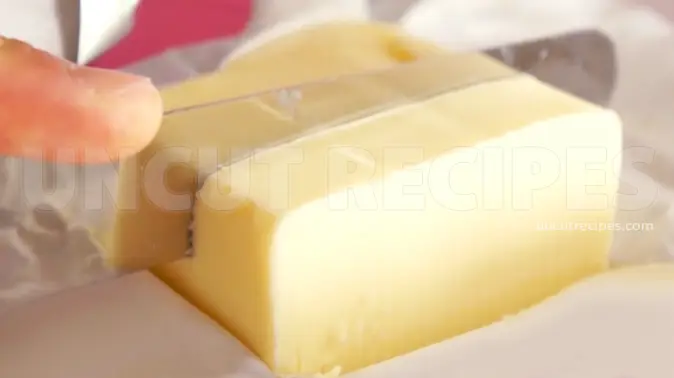
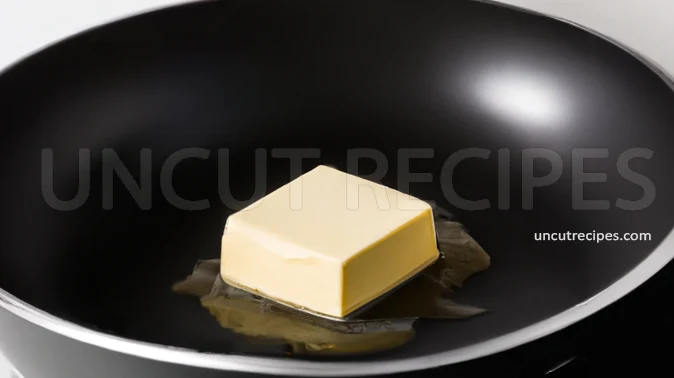
03 - Create the Sauce: Now, it's time to make the sauce! Add boiling water from the pasta pot. This will help the cheese melt into a smooth sauce in a minute.
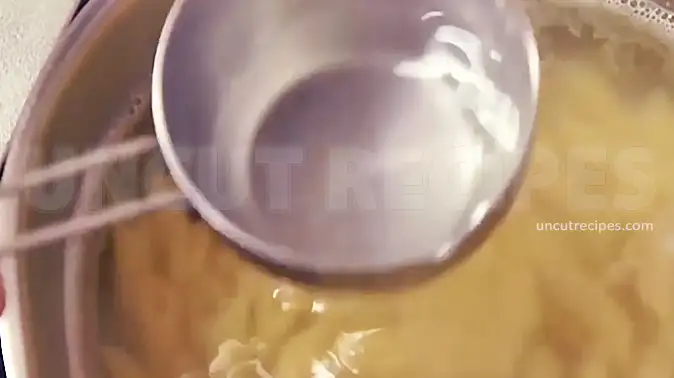
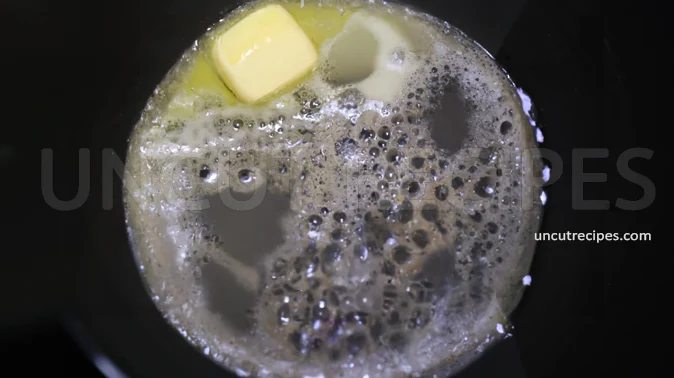
04 - Now it's time to add the Philadelphia Cream Cheese into the pan with the melted butter and water and stir the Cheese until it has formed a smooth sauce.
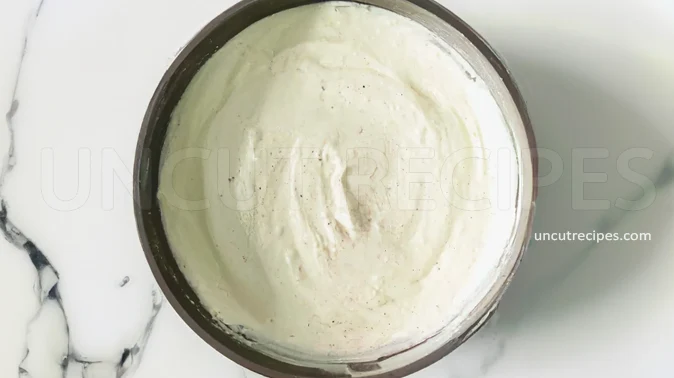
05 - Once your pasta is cooked 'al dente' (which means it's cooked but still has a bit of a bite to it), drain it and add the drained pasta directly into the saucepan with the Cream Cheese sauce. Let it cook for a few more minutes until most of the Water has evaporated and you're left with a smooth, creamy sauce.
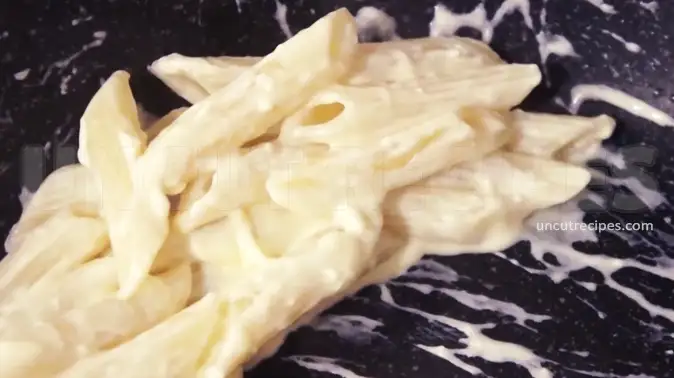
06 - Add the Black Pepper into the saucepan. Give everything a good stir to mix the flavors together. This will add a touch of warmth and spice to your creamy pasta dish.
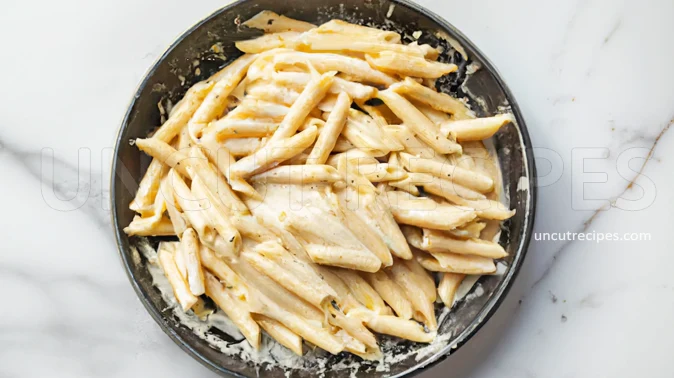
07 - Mix and Serve: Continue to stir your pasta and sauce together until they're fully combined. The pasta should be beautifully coated in the creamy cheese sauce. Serve your delicious pasta dish hot and enjoy!

Notes:
Penne Pasta: Penne is used here because the cheese can easily enter inside the pasta's hole, making the dinner more enjoyable, but you can use any pasta shape you prefer or have on hand.
Philadelphia Cream Cheese: Philadelphia is a brand of cream cheese that's widely available and known for its creamy and rich texture. However, you can use any brand of cream cheese you prefer. If you like a tangier flavor, you could also consider using a blend of cream cheese and sour cream.
'Al Dente' Pasta: Cooking pasta 'al dente' (which translates to 'to the tooth') means that the pasta should be cooked so that it still has a bit of firmness when bitten, so you can finish cooking it inside the sauce.
Cooking the Pasta in the Sauce: Cooking the pasta in the sauce for a few minutes helps it to absorb the flavor and makes the sauce adhere better to the pasta.
Additional Toppings: For added flavor and texture, you could garnish your pasta dish with ingredients like chopped fresh herbs (parsley, basil), grated cheese (Parmesan, Pecorino), or crushed red pepper flakes for some heat.
Making Ahead: If you're planning on making this dish ahead of time, keep the sauce and pasta separate until you're ready to serve. You may need to thin out the sauce with a little pasta water or milk when reheating.
Storing and Reheating: Store leftovers in an airtight container in the refrigerator for up to 3 days. Reheat in a saucepan over medium heat, adding a little water or milk to help the sauce regain its creamy consistency if needed.
Freezing: It's not recommended to freeze this dish as the cream cheese sauce might change in texture when thawed and reheated.
Making it Healthier: For a healthier version, you could use whole wheat pasta and a lower-fat cream cheese.
Nutritional Information
( Per Portion )
|
Calories |
600 kcal (30%) |
| Total Carbohydrate | 60g (20%) |
| Cholesterol | 80mg (27%) |
|
Total Fat |
30g (46%) |
| Saturated Fat | 15g (75%) |
| Polyunsaturated Fat | 2g (13%) |
| Monounsaturated Fat | 10g (62%) |
| Trans Fat | 0g |
| Fibers | 3g (12%) |
| Protein | 20g (40%) |
| Sugar | 5g (20%) |
|
Vitamin A |
1000 IU (20%) |
|
Vitamin B1 (Thiamin) |
0.6mg (40%) |
| Vitamin B2 (Riboflavin) | 0.4mg (24%) |
| Vitamin B3 (Niacin) | 6mg (30%) |
| Vitamin B5 (Pantothenic Acid) | 1mg (10%) |
| Vitamin B6 | 0.1mg (5%) |
| Vitamin B7 (Biotin) | 15mcg (50%) |
| Vitamin B9 (Folate) | 100mcg (25%) |
| Vitamin B12 | 0.5mcg (20%) |
| Vitamin C | 0mg (0%) |
| Vitamin D | 10 IU (3%) |
| Vitamin E | 1mg (5%) |
| Vitamin K | 5mcg (4%) |
| Choline | 50mg (0%) |
| Carnitine | 10mg |
|
Calcium |
200mg (20%) |
|
Chloride |
100mg (4%) |
| Chromium | 15mcg (13%) |
| Copper | 0.2mg (10%) |
| Fluoride | 0.01mcg (0%) |
| Iodine | 50mcg (33%) |
| Iron | 2mg (11%) |
| Magnesium | 50mg (12%) |
| Manganese | 0.5mg (25%) |
| Molybdenum | 15mcg (33%) |
| Phosphorus | 300mg (30%) |
| Potassium | 300mg (6%) |
| Selenium | 15mcg (27%) |
| Sodium | 400mg (17%) |
| Sulfur | 100mg |
| Zink | 2mg (18%) |
* Percent Daily Values are based on a 2,000 calorie diet. Your daily values may be higher or lower depending on your calorie needs.
** Nutrient information is available for all ingredients in this recipe. Amount is based on available nutrient data collected from all over the internet.
(-) Information is not currently available for this nutrient. If you are following a medically restrictive diet, please consult your doctor or registered dietitian before preparing this recipe for personal consumption. |
| Written by: Uncut Recipes | Disclaimer |




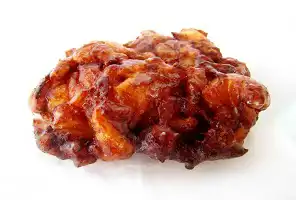
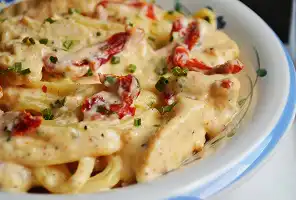
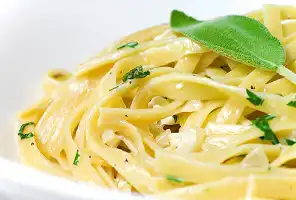
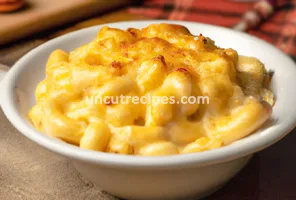


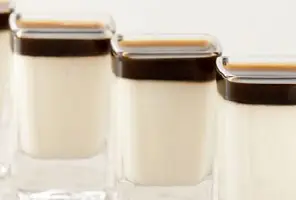
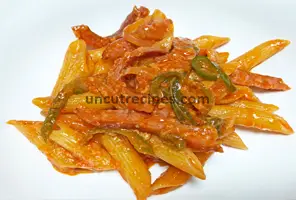

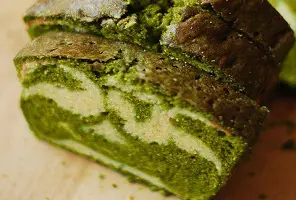
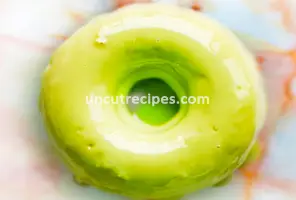
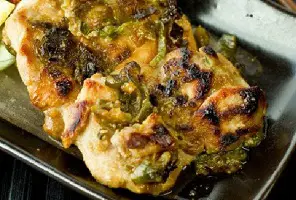


August 03, 2023
Loved this dish! I made it for a quick weeknight dinner. The cream cheese really added a new level of yum to the penne pasta.